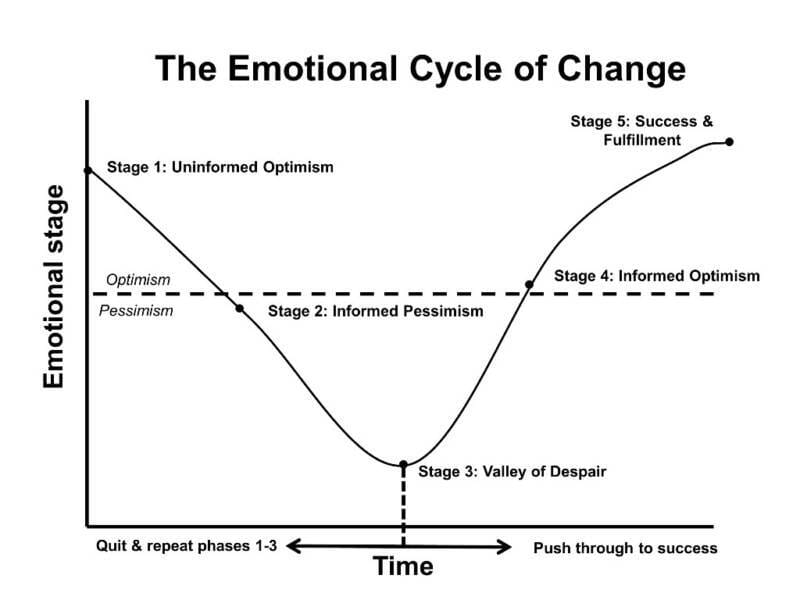- The GrowthPlug Newsletter
- Posts
- The Hidden Cycle of Starting Something New
The Hidden Cycle of Starting Something New
Starting something new often follows a predictable emotional cycle—from excitement to frustration to eventual mastery. Understanding this cycle helps you push through the dip and build lasting momentum, even when motivation fades.
We’ve all been there.
You decide to launch that new project, start a side hustle, learn a language or skill, join a gym, or adopt a new productivity system. The idea feels electrifying and exciting.
You’re buzzing with possibilities. You imagine how your future self will thrive.
Then—two weeks in—something shifts.
You’re no longer riding the dopamine high. You’re stuck. Things feel messy. You start questioning the whole idea.
Guess what? This is normal.
There’s a psychological and behavioral cycle that almost every new endeavor follows—and understanding it can help you stick with what matters when it counts most.

Let’s break it down.
1. The Motivation Surge (Enthusiasm Phase)
Also known as the uninformed optimism stage (from the “Emotional Cycle of Change” framework), this is when we feel most motivated.
What’s happening?
Dopamine—the brain’s "anticipation and reward" chemical—is surging.
You're operating in what's known as the ideation zone, driven by possibilities, not yet grounded in reality.
Cognitive load is low. You haven’t encountered complexity yet.
Why it feels good:
Novelty stimulates the brain.
Vision is clear. Obstacles are invisible.
You’re emotionally connected to the potential outcome.
Common pitfalls:
Overcommitting.
Underestimating how long or hard it will be.
Failing to build systems that will sustain action.
2. The Reality Dip (Disillusionment Phase)
Here comes the dip. This is what Seth Godin calls “The Dip”, and what psychologists label informed pessimism.
What’s happening?
Your mind begins evaluating effort vs. payoff.
The task complexity increases.
The reward (outcome) still feels distant.
Emotions:
Frustration, confusion, overwhelm. You might say, “This is harder than I thought.”
The risk:
This is where most people quit. Not because the goal isn’t worthwhile, but because they mistake discomfort for failure.
3. The Grit Phase (Adjustment + Discipline)
If you push through the dip, you enter the conscious competence phase (per the Four Stages of Competence model). You’re gaining skill—but it still takes effort.
What’s happening?
Habits begin forming (if you stay consistent).
Your brain starts to rewire through neuroplasticity.
You’re moving from effort to rhythm.
What helps here:
Clear systems (e.g. time-blocking, habit stacking).
Environmental cues and social accountability.
Focusing on process, not just outcome.
This is the stage where you build identity: “I’m someone who does hard things.”
4. The Momentum Shift (Breakthrough Phase)
This is where you experience flow more often—defined by Mihaly Csikszentmihalyi as the state of full engagement and immersion.
What’s happening?
Tasks feel easier.
Feedback loops are tighter.
Motivation returns—not as a surge, but as steady energy.
Caution:
This is also when people can coast or shift focus prematurely. Keep stretching yourself with new goals or challenges to stay sharp.
5. Mastery or Plateau (Sustain or Renew Phase)
At this stage, you’re either embedding the new behavior into identity (automaticity) or starting to feel bored or stagnant.
What’s happening?
Neural pathways are established.
You’ve reached the unconscious competence level.
Your challenge now is sustainability or reinvention.
Your next decision:
Keep doing this with minor tweaks?
Level up?
Start the cycle over with a new skill or challenge?
Key Takeaway: Progress Isn’t Linear. It’s Cyclical.
Starting something new isn’t a straight path from motivation to success. It’s a predictable series of highs, lows, and inflection points.
You don’t need constant motivation. You need a system to survive the dip, and the discipline to keep going when motivation fades.
Next time you feel stuck or discouraged in something new, don’t panic. You’re not broken. You’re just in the messy middle—and that’s where real growth happens.
Try This Today:
Think about something you recently started.
Which phase are you in?
What do you need: a reset, a push, or a pause?
Who or what can help you move forward?
If you’re in the dip, good. That means you’re right on schedule.
Let’s keep growing—one cycle at a time.